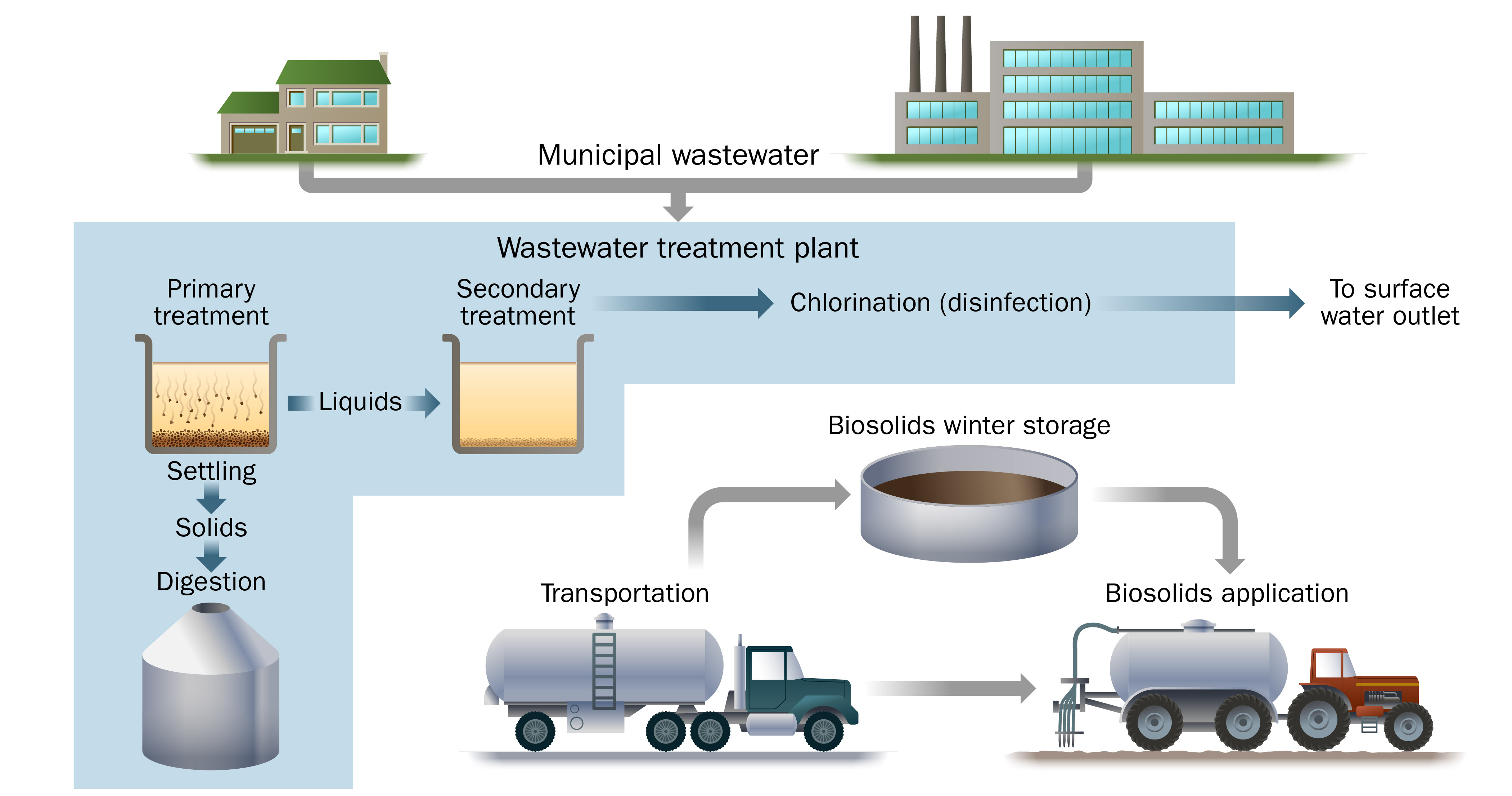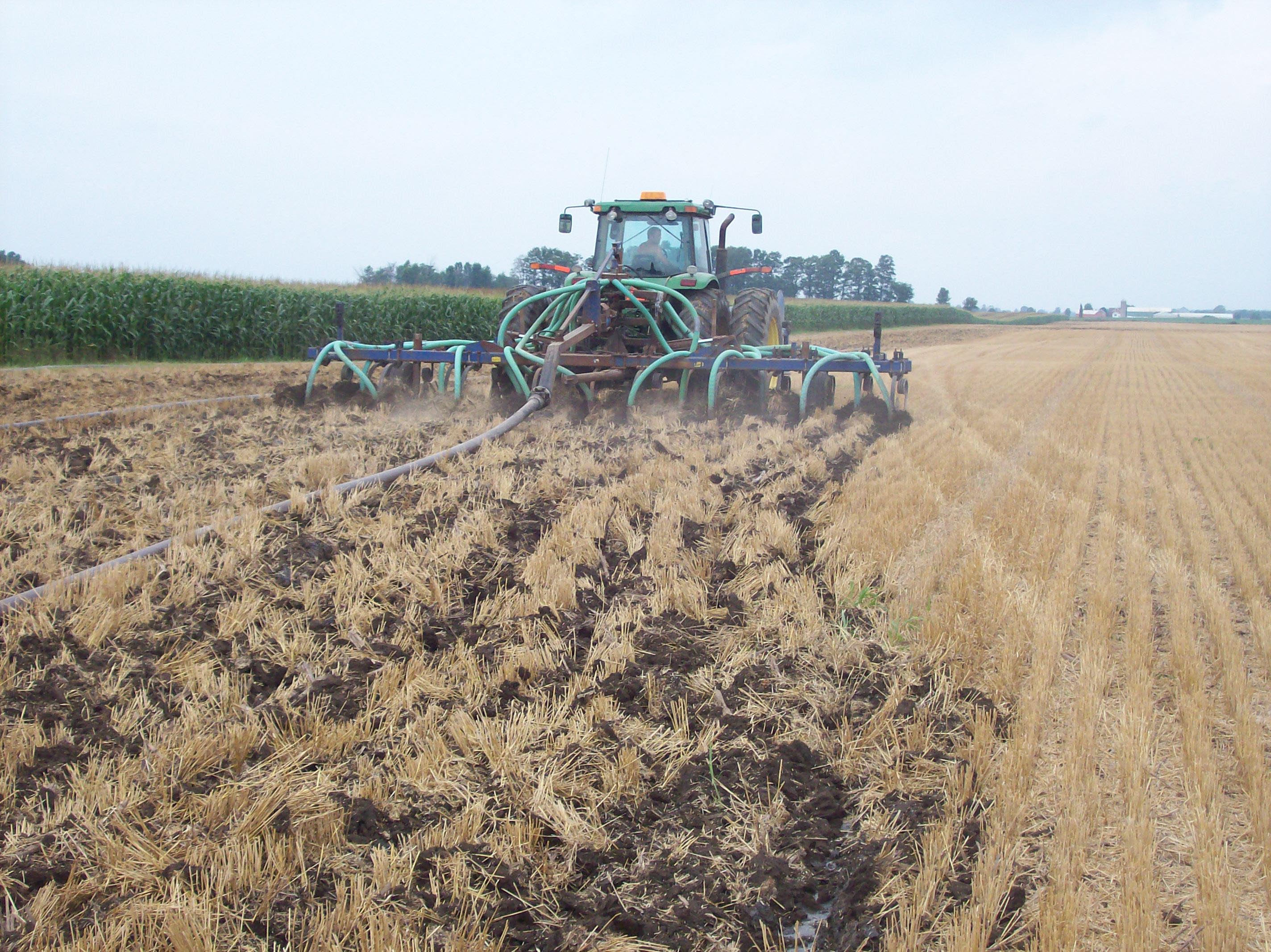Sewage biosolids: managing urban nutrients responsibly for crop production
Learn about getting the most benefit from biosolids while following the regulations and minimizing the risks to the environment and human health. This technical information is for Ontario producers.
ISSN 1198-712X, Published January 2023
Defining sewage biosolids
Sewage biosolids are produced when municipal wastewater treatment facilities treat wastewater from residential, industrial and commercial sources into treated water and leftover solids (Figure 1). The treated water is normally discharged to a nearby stream or river, while the solids go through an additional treatment process to reduce the presence of potentially harmful micro-organisms and odours. Treated solids that meet the regulatory requirements, including quality standards, are known as sewage biosolids.

Bylaws regarding municipal sewer use help control the quality of the wastewater received at sewage treatment plants as well as the sewage biosolids, in terms of regulated metals and other substances, to minimize their impact on the environment.
This fact sheet looks at getting the most benefit from the biosolids while following the regulations and minimizing the risks to the environment and human health.
Benefits of sewage biosolids
Sewage biosolids have been beneficially used in Canada, the U.S. and Europe for more than 30 years. In Ontario, they are used to restore the vegetative cover of disturbed sites (such as mines) or for other non-agricultural applications, but they are most often applied to agricultural land. Agricultural land that receives sewage biosolids is commonly used to grow crops for livestock feed or fuel production (for example, hay, corn and soybeans). It is not usually used for fruits and vegetables.
The application of sewage biosolids to agricultural land helps maintain or improve soil fertility. It contains nutrients that are beneficial and important to plant growth, such as:
- mineral and organic nitrogen
- phosphorus
- micronutrients such as zinc, magnesium and copper
Adding organic matter to agricultural land enhances soil structure, moisture retention and permeability while reducing the potential for wind and water erosion.
The beneficial use of biosolids also offsets the need for fertilizers that may rely on limited natural resources or more energy for their production.
Applying sewage biosolids to land in accordance with regulations and best management practices gets the most benefit from the biosolids while minimizing risks to the environment and human health. It follows the principles of a circular economy and offers economic and environmental advantages to communities by recycling nutrients and organic matter in the environment (Figure 2).

Regulations
In Ontario, some sewage biosolids are offered for retail sale as a fertilizer or a supplement and must comply with the Fertilizers Act, 1985, and Fertilizers Regulations. Sewage biosolids that are not sold under the Fertilizers Act, 1985, and the Fertilizers Regulations can be applied to agricultural land as a non-agricultural source material (NASM) under the requirements of the Nutrient Management Act, 2002 (NMA) and O. Reg. 267/03, Nutrient Management Regulation (NM regulation).
In general, Part V (Waste) of the Environmental Protection Act, 1990, (EPA) and Regulation 347 governs all waste management activities in Ontario. The transportation, storage and disposal of waste, including land application of waste materials, requires an environmental compliance approval (ECA) issued by the Ministry of the Environment, Conservation and Parks (MECP). In the case of transportation activities, parties may have the option to register as a waste transportation system under Environmental Activity Sector Registry (EASR) regulation O. Reg. 351/12 rather than have an ECA. Some waste management activities are specifically exempt from requiring an ECA. For example, the management of sewage biosolids that are sold as a fertilizer or supplement under the Fertilizers Act, 1985, and the Fertilizers Regulations can be exempt from requiring an ECA if the biosolids are “transferred by a generator for direct transportation to a site to be promptly packaged for retail sale to meet a realistic market demand or offered for retail sale to meet a realistic market demand.”
While sewage biosolids that are sold under the Fertilizers Act, 1985, and the Fertilizers Regulations may often be exempt from the requirement for an ECA, some rules under the NM regulation may apply to the land application of these materials when a farm unit is required to have a nutrient management strategy, nutrient management plan (NMP) or a NASM plan.
Managing sewage biosolids as a commercial fertilizer
Under the NM Regulation, sewage biosolids that are sold under the Fertilizers Act, 1985, and the Fertilizers Regulations are considered “commercial fertilizers.” Although the NM regulation does not impose standards on the transportation or storage of “commercial fertilizers,” it does stipulate land application rules that apply to farm units that are required to have an NMP or a NASM plan.
Note: On farm units required to have a NASM Plan, these land application rules only apply within the defined NASM Plan Area, and they only apply during a year where NASM is land‑applied within that NASM Plan area.
Land application rules for “commercial fertilizers” under the NM Regulation are:
- No person shall apply commercial fertilizer to land closer than 3 m to a water well that is not a municipal well.
- No person shall apply commercial fertilizer to land closer than 100 m to a municipal well.
- No person shall apply nutrients within the vegetated buffer zone except for an amount of commercial fertilizer that is reasonable to establish or maintain the vegetation of the vegetated buffer zone,
- in accordance with a determination of the concentration of plant-available phosphorus and plant-available potassium in the soil of the vegetated buffer zone
- in accordance with the Agronomy Guide for Field Crops and
- in such a manner that the agronomic balance does not exceed zero
- Commercial fertilizers can be applied within 13 m from the top of the bank of a surface water if the application is done in accordance with the NM regulation and at least one of the following conditions is satisfied:
- The materials are applied by injection or placement in a band below the soil surface.
- The materials are incorporated within 24 hours of application.
- The materials are applied to land covered with a living crop.
- The materials are applied to land with crop residue covering at least 30% of the soil, as determined in accordance with the Nutrient management protocol.
In addition, the NMA prohibits land-applying any nutrient that contains human body waste between December 1 and March 31, including commercial fertilizers derived from sewage biosolids. This prohibition applies to:
- any farm unit that is required to have a nutrient management strategy, nutrient management plan or NASM plan (see note)
- any farm that has received anaerobic digestion output and
- any parcel where the number of farm animals on the farm unit is sufficient to generate more than five nutrient units of manure annually
The application of sewage biosolids that are not offered for retail sale but intended to be applied to land other than agricultural land (such as a forested or land reclamation site) requires an ECA, as there are no exemptions for this activity under Part V of the EPA.
Managing sewage biosolids as a non‑agricultural source material
If not sold as a “commercial fertilizer” under the Fertilizer Act, 1985, and Fertilizers Regulations, sewage biosolids may be applied to agricultural land as a NASM. Under the NM regulation, sewage biosolids are considered a Category 3 NASM and may be land-applied to a NASM plan area at an agricultural operation under the rules set out in the regulation.
Note that the land application of NASM in a NASM plan area as defined in the NM regulation is exempt from requiring an ECA issued by the MECP under Part V of the EPA and Regulation 347. The hauling of NASM from the generator site to a farm’s NASM plan area does require an ECA or EASR.
The NM regulation ensures that the application of NASM is of benefit to crops, does not degrade the natural environment and doesn’t pose any harm to human or animal health. It sets out criteria for:
- NASM quality, including beneficial use criteria plus standards for specified pathogens and metals, as well as odour criteria
- the amount, method and timing of application
- separation distances from sensitive areas, such as wells, surface water and neighbouring homes and businesses
- suitable soil types and topography
Some additional requirements that apply to sewage biosolids when managed as NASM include the following:
- All on-farm storage and land application must occur in accordance with an approved NASM plan issued by the Ministry of Agriculture, Food and Rural Affairs (OMAFRA).
- Sewage biosolids cannot be applied between December 1 and March 31 or anytime the soil is snow-covered or frozen, as defined in the NM regulation.
- Temporary field nutrient storage of NASM that is dewatered municipal sewage biosolids with an “OC1” or “OC2” odour category is restricted to a maximum of 10 days. NASM with an OC3 odour category must be land-applied on the same day it is received at the farm.
- NASM application rates must not exceed plant-available nitrogen or phosphate limits specified in the NM regulation, whichever is the most restrictive, but also must not exceed 22 tonnes/ha, calculated on a dry weight basis, in any 5-year period.
Scientists, health experts and agrologists regularly review the regulatory requirements and standards for applying sewage biosolids to land. This review is to ensure the NM regulation and its standards continue to protect food safety, human health and the environment. Requirements are revised as needed, based on new science or technology.
Resources
Read the OMAFRA NASM webpage for a more detailed overview of how to manage NASM in Ontario under the NM regulation.
For more information on best management practices to manage sewage biosolids:
- Application of Municipal Sewage Biosolids to Cropland
- OMAFRA fact sheet, Temporary field storage of non-agricultural source material
Disclaimer
The information in this fact sheet is provided for informational purposes only and should not be relied upon to determine legal obligations. To determine your legal obligations, consult the relevant law. If legal advice is required, consult a lawyer. In the event of a conflict between the information in this factsheet and any applicable law, the law prevails.
This fact sheet was written by Benoit Lebeau, P. Eng., non‑agricultural source materials, OMAFRA.